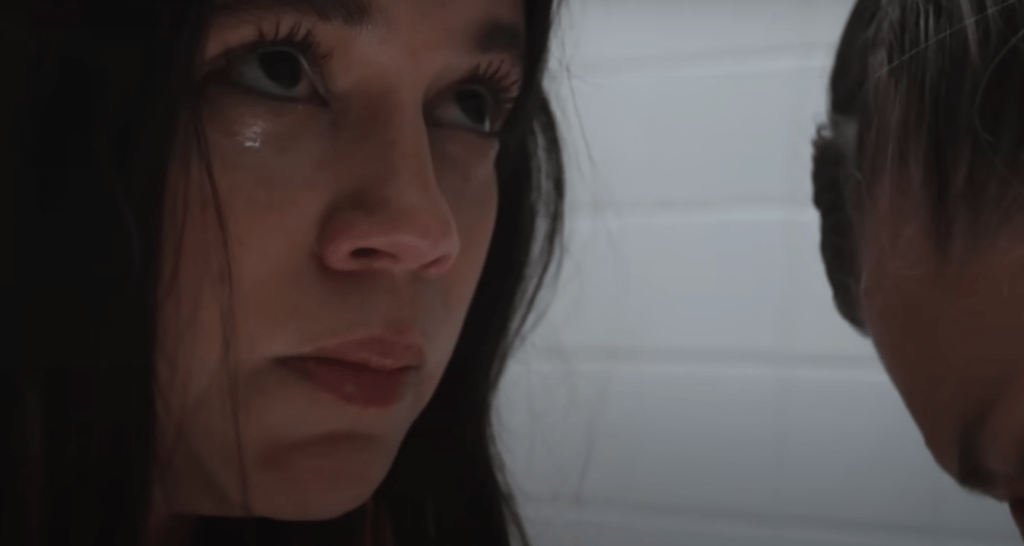The Case for the Trauma Plot: Healing is About Sharing in “The Fallout”

The Fallout, a newly-released high school drama film, is about a school shooting and the way everybody responds differently to trauma. The film explores school shootings in a more delicate, material, meatier way than a news story can. Breaking news stories focus on the blood, the death, but what about the long-term trauma experienced by those who survived? What about the fallout?
The film follows Vada Cavell’s (Jenna Ortega) journey after experiencing a school shooting. Vada’s a Sapphic tomboy who experiences the event in the bathroom, alongside Instagram-famous dancer, Mia (Maddie Ziegler from Dance Moms!).
Just before school shooting, Vada flirts with Mia, who’s re-applying her makeup in the bathroom mirror. “You don’t need makeup,” Vada says, popping a cheeky grin. Then the first bullet sounds. They hide in a bathroom stall together while the massacre takes place. They become each other’s healing buddy thereafter, experimenting with drugs, rage, and each other, to make it through.
The film is earnest in its portrayal of trauma: the popularly used, often viewed as overused, word for a very real phenomenon. Bessel Van Der Kolk, the author of The Body Keeps the Score (a book everybody should read by the way), describes trauma as “an injury, a wound, something that happens to you that is too big for your mind to comprehend,” in the video below.
“You get stuck, things keep coming back, and you’re overwhelmed again and your mind, brain, and your being, are incapable of making sense out of that event,” he continues. “Because you cannot integrate it, it keeps on coming back.”
Parul Sehgal wrote, for The New Yorker, “The Case Against the Trauma Plot.” Parul argues that, unlike the marriage plot, which “direct[s] our curiosity toward the future,” the trauma plot directs us back to the past. Believing that Post Traumatic Stress Disorder (PTSD) is over-diagnosed, to the point a historian can “be a casualty of vicarious trauma,” she makes the case that art is obsessed with trauma because society is.
I disagree. We all will, at some point in our lives, experience a level of trauma. Not everybody will develop PTSD, but the rise in diagnosis reflects the biological repercussions of psychological injury. It’s serious. Like Bessel Van Der Kolk implies, we are traumatized when we can’t make sense of the event – when we can’t integrate it into our lives. That means the state of being traumatized doesn’t have to be permanent if we heal and integrate. Art is therapeutic.
Why are there more “trauma plots” today? Many reasons. Firstly, when your society or culture prevents you from speaking about trauma for centuries, you’re going to blurt out a lot when it’s more accepted. We don’t exist as a single being. Many of us carry the unspoken traumas of our ancestors. Shoving the words back into our guts for the sake of other people’s comfort is regressive.
Secondly, while we’ve now got a readily-used word for severe mental turmoil resulting from a particularly overwhelming event, sometimes leading to psychological disorder, we live in a world more individualized than ever before. We might be more likely to accept our wounds but humans heal best collectively. Trauma plots, to me, are a way to connect with others in a world where we’re supposed to compete.
In the face of trauma, we need more than a psychologist: we need communal nurturing. One of the most evident symptoms of trauma, especially if it revolved around somebody else’s actions, is an immense distrust for other people. Makes sense. If, for example, you’ve been brutalized by a man, then you’re likely to distrust men. Racial trauma leads to the distrust of white people.
The remedy for trauma is bringing down the walls of individualism. Communicating through art can do that in ways one-on-one traditional psychology struggles to. Remembering that trauma is something we can’t always make sense of, it’s often more fruitful to dig into our subconscious and make art about our experience than it is to describe the facts to a well-meaning, but clinical, psychologist. This isn’t a case against psychology as a practice, it’s a case for opening our minds to ways of healing beyond individualized therapy.
I’m not psycho-analyzing the debut director of The Fallout, Megan Park, either. Trauma plots don’t always reflect the experience of the writer, artist, or director. You can, for example, be a victim of a car crash but heal from it by distancing yourself from the event a little bit, making art about something similarly traumatic, like a plane crash, instead.
A nuanced, well-written trauma plot is a sad, but enjoyable, blues song. Music? Drawing? Writing? It’s all art. Humans share suffering. The case for trauma plots is that we should share healing, too.



